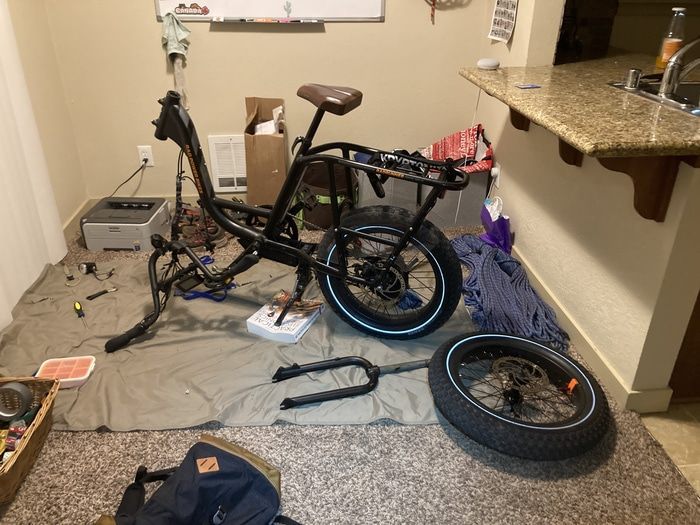I like e-bikes
I sold my van before heading to Europe for the summer. I’m looking to buy a hybrid or plugin hybrid for my next car. I considered a full electric but our apartment complex does not allow anyone to use the 110V sockets next to the carports. I’m not sure why they were installed there in the first place. We could use the Level 2 and Level 3 chargers at UW-Bothell, but my understanding is that fast-charging reduces the lifetime of a battery.
RadRunner 1 with LCD display
I bought a used RadRunner 1 on Facebook Marketplace. It was a bargain, but it came with several defects. The front fork was bent so I visited the local Rad Power Bikes store and bought a new one for $45. The rear tire had a slow leak that I located and patched. The rear disk brake rotor was bent but it was easy enough to reshape using an adjustable wrench. It was also missing the rear torque arm and bolt which Rad Power Bikes gave me free of charge. Finally, I gave it a good wash and cleaned all the grit out of its chain and it’s been riding smooth.
How the bike spent its first week
I bought the bike with 6,000 miles and I have ridden 200 so far. I’m glad I went with the RadRunner. There are many brands of e-bikes out there, but Rad Power Bikes is one of the largest. This means that service centers, spare parts and accessories are easy to source. The range is also very good. If the battery is original, it’s impressive that I can go 30 miles with no pedaling on a full charge. This range is enough for round-trips to the grocery store, coffee shop, mall, climbing gym or running club. It’s also a two-seater and I recently took Cassondra on a 12 mile ride using only half the battery charge.
For security, I bought a Kryptonite Keeper 712 lock which is a 3-foot chain that offers a 5/10 safety rating from Kryptonite. It’s not the strongest lock, but it’s long enough to wrap around larger posts like the one supporting our carport. I also remove the battery whenever it’s out of sight since that’s the most expensive part of the bike. The battery is very easy to carry and doesn’t take up a lot of room in my backpack. Removing the battery also extends its life by protecting it from excessive heat, cold and moisture.
Carport post where I keep it locked up
The battery charging takes a few hours so I am unable to make two long trips in quick succession. I don’t know what the etiquette for charging bike batteries in public places like Starbucks is, but at 672 Wh, a full charge costs less than $0.10. I think that’s okay. The bike is also a bit heavy (around 65 lbs) but if you grip in the right places it’s not too strenuous to carry it up and down the stairs of our apartment if needed. I mostly keep it locked up outside in the corner of our carport.
Riding the bike without pedaling can get you quite chilly and this morning, with the temperature below 50 degrees, I found myself wishing for gloves to keep my hands warm. I usually put on a sweatshirt and a puffy jacket for the ride, even if it’s t-shirt weather. For navigation, I prefer using Apple Maps to Google Maps because I keep the phone in my pocket and Apple does a better job of verbalizing the directions (i.e. turn at the next stop light, turn at the next stop sign, in 2 miles turn left onto X street). This means I seldom have to look at the map.
6000 miles and more to come
Those are my thoughts on the first 200 miles. Right now it feels possible to meet all my urban travel needs with electricity but inclement weather might change that outlook. The bike can’t get me to the mountains so I will continue looking for a car, but likely something with a gas tank and good gas mileage for long range travel.



